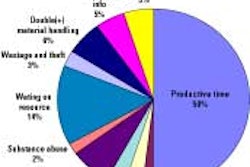Most firms do annual employee evaluations. Some managers do them well. In too many cases, both the evaluator and the evaluatee look forward to the process with about as much enthusiasm as a trip to the dentist. Perhaps you are a manager who cringes at the thought of doing employee evaluations because you find it difficult to judge or rank people. While you're not alone with that thought, there are things that you can do to not only make it easier for yourself, but also make the process more effective.
Let's look at the employee evaluation process - the reasons for doing it, some methods for approaching the process and even some different ideas to try. Bottom line: Done properly, an employee review/evaluation can be a productivity-enhancing coaching opportunity that pays big dividends for your organization.
Reasons for evaluations
Employee evaluations provide the manager and the employee with honest and accurate feedback on performance in order to set performance goals and the employee's salary. There are other motives for these evaluations as well.
As you look at the dynamics between a supervisor and employee, most workers want to know where they stand with their supervisors. They value knowing what is expected of them. Feedback helps them understand what work is being done well, what needs to be changed or corrected, and the positive or negative consequences of their performance.
Performance evaluation is a useful process which validates recruiting and hiring: Are you bringing in employees who are capable of performing the duties the job requires? It is also a critical tool in assessing your feed and grain firm's training and staff development programs. Finally, annual evaluations serve as the first step in addressing problematic or poor employee performance.
Approaches to evaluation
Two items should be in place long before the actual evaluation.First, a good job description is essential for the basis for an evaluation. It should detail the functions of the employee's position, and provide a good understanding of the employee's job duties. This cannot be the description drafted in 1958 when the mill was started. It needs to be current, and the employee must know what is expected. How can you possibly evaluate a person who really has no idea as to what the "measuring stick" is?
Second, an employee file is a useful accompaniment to the job evaluation. It should contain information about the employee accumulated throughout the evaluation cycle - work on special projects, training they received, commendations or complaints. As a part of the employee file, periodic reviews and comments should be added. This allows for timely, continuous and consistent performance feedback - which substitutes for the poor memory that some of us seem to have! (As an aside, while our focus here is the annual review, a good supervisor will have formal or informal conversations throughout the year with employees. There really should be few surprises either way during the annual review.)
Objectives and goals should have been prepared at the beginning of the previous management period. You as manager can then use the job description as a springboard to develop a set of performance goals for the employee. Often the approach here is for you and the employee todevelop your respective sets of goals, and then compare and have a "meeting of the minds" during the performance review. Your expectations should include basic standards of performance related to job duties, more subjective elements such as teamwork and communication. Clarity in your expectations is key. An employee cannot read your mind, nor be held accountable for something you can't articulate.
It is important to consider changes that may have occurred in your business during the evaluation cycle that may have affected your employee's performance, organizational or operational changes, such as the introduction of new technology, new procedures or staff shortages.
Employee evaluations are subjective and contain your managerial opinion, but strive to base your opinion on facts or behaviors. Your ratings and remarks should reflect actual performance - exceptional, average or below standard. Resist the temptation to let recent events dominate your evaluation. This can cause frustration with your good employees who wonder if you were paying attention the rest of the year, and sends the message to the poor performer that they only have to perform just before evaluation time.
As manager, you should attempt to evaluate each performance element individually. Don't let excellent or poor performance in one area determine the tone of the whole evaluation.
Another element to consider is asking your employees to do a self-evaluation. Many managers have found that this takes unpleasant surprises out of the review process, and serves the purpose of making the evaluation process interactive. It also helps the employee focus on their accomplishments for the past year and set goals for the coming year. There are also some additional benefits of using a self-evaluation:
- Your worker will be able to remember what happened during the past year better than you will. Without a self-evaluation, you may forget something significant the employee accomplished earlier in the year.
- A self-evaluation can give you an early warning that the employee believes they deserve a higher rating than you do.
- A self-evaluation indicates to the employee that you want the review to be a give and take session, not just "one-way conversation" coming from you as their boss.
A good self-evaluation form assists your employees in reconstructing the year. Some examples of possible questions to include in a self-evaluation are:
- List your top three accomplishments for the year.
- What work did you enjoy the most and why?
- Rank your job knowledge (do you possess the knowledge and skills required to accomplish your duties)?
- Discuss how you take initiative (take responsibility for determining what needs to be done).
- Discuss your dependability.
- Describe how you show teamwork (cooperate and work effectively with others).
- How well do you communicate (with your supervisor and your peers)?
- Describe your decision-making abilities - how well do you take responsibility for and make decisions within your assigned authority?
Depending on the size of your business and how many employees you have at each level, you may want a rating scale for each area measured. This can be as simple as below average, average and above average (We give some additional examples below.) Or, you can describe in more specific terms what below average, average, and above average (or whatever scale you use) looks like for each area being measured. Descriptions of the behavior you want can help employees see that where they are is not where you want them. You can still use open-ended questions for examples and illustrations.
Preparing for the review
Good preparation leads to effective performance evaluations. Here is a checklist of things to do prior to conducting your employees' performance reviews:
- Find a quiet space with no distractions - no phones, no e-mail, no open doors - and schedule adequate time for the review. This IS important. We hear horror stories regularly about supervisors not taking the process seriously, taking calls during evaluations, etc. Rest assured, EVERY signal you send during an evaluation will be interpreted in some way by the employee.
- Prepare a draft of the performance evaluation to guide your discussion.
- Think about what the "take home" message is for your employee. Superior performing employees should leave the evaluation with opportunities for new responsibilities and with guidance on how to maintain their performance level; employees performing at a satisfactory level should be able to identify opportunities for their development and discuss with you ways to maintain and improve their performance; with poor performers you should strive to develop a plan for performance correction and try to gain their commitment for improvement.
The evaluation agenda
An agenda for the performance evaluation might include the following:
- Greeting - Start with a sincere greeting and perhaps some small talk.
- Summary - Some managers like to start with a summary of the employee's overall performance, including the rating they will give. Others like to leave this until after a discussion of strengths and weaknesses. Either approach is okay, it's just a good idea to summarize your evaluation at some point during the review.
- Strengths - Compliment the employee on what they have done well. Cite specific examples (this is where the employee's self evaluation is helpful - seeing their list of accomplishments). Specifics are important - employees want to know you care enough to notice.
- Weaknesses - Cite specific examples and what can be done to change their performance. Specific examples make your comments more effective. Do note: In general, there should not be big surprises here. If an employee is struggling, your coaching should not wait for the end-of-year review.
- Feedback - Ask for your employee's thoughts on your comments. Don't argue, but listen. If necessary, let the employee know that their feedback has not changed your evaluation.
- Salary - If setting your employee's salary is a part of the review, recap your evaluation and announce the new salary and effective date. Or, provide a timeline on when action will be taken.
- Planning - In many cases, some discussion of the next 12 months will be a part of the process - goals, objectives, things to work on, professional development. This can be a great time for some coaching/career counseling and send the message that you care about the long-term success of the employee.
- Closing - Unless you're dealing with a poor review, end your session positively by letting your worker know how much you value them and their contributions.
Good luck!
Evaluations can be a challenge, but they are a necessary component of every feed and grain business.



















